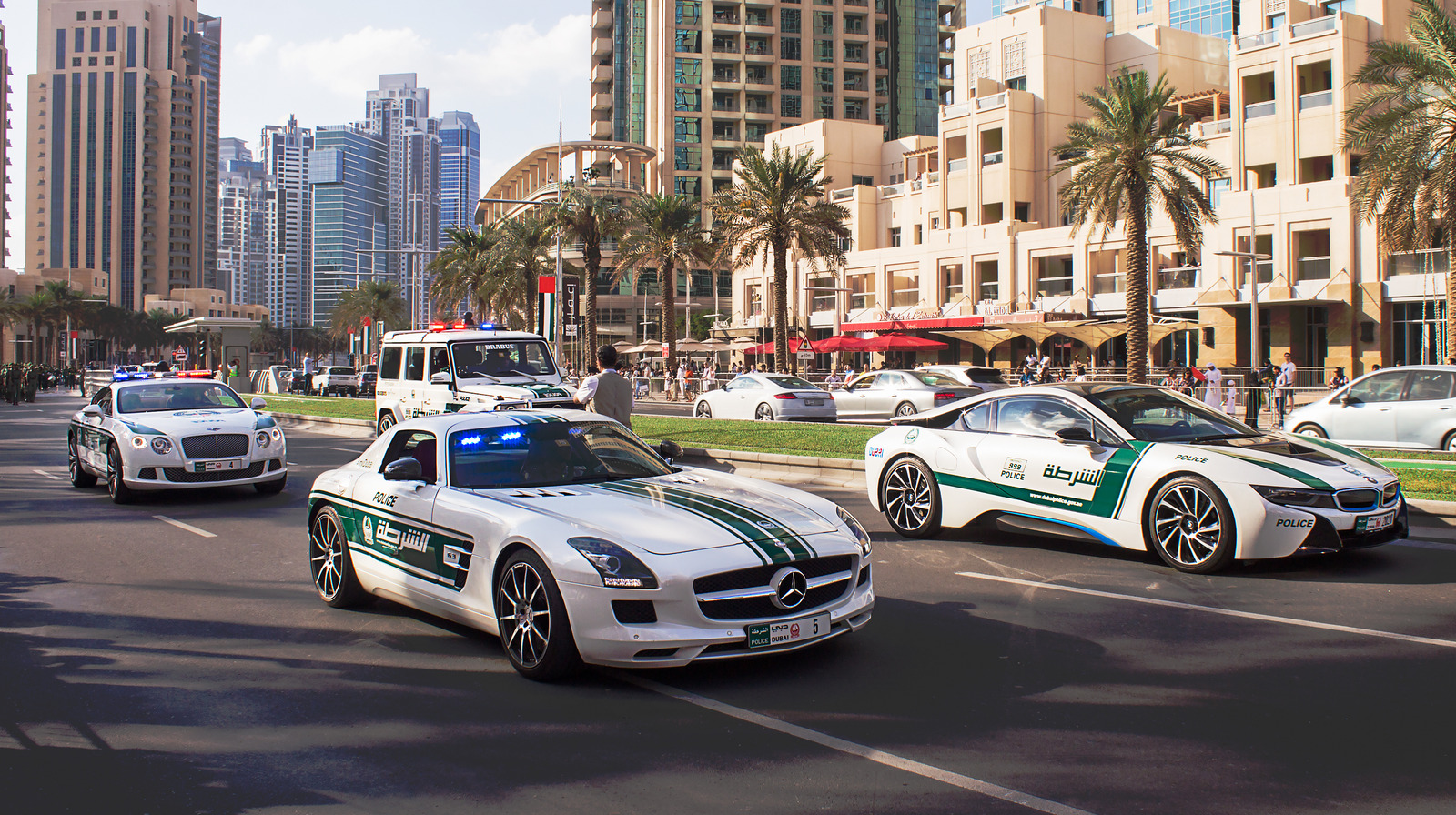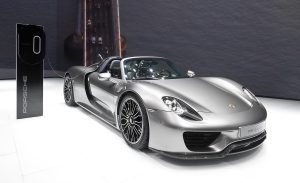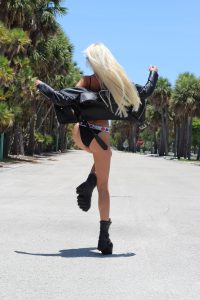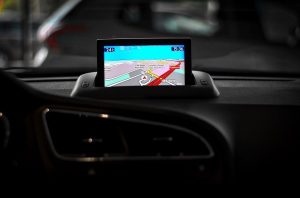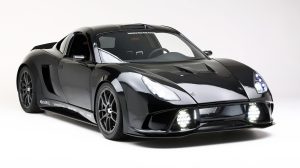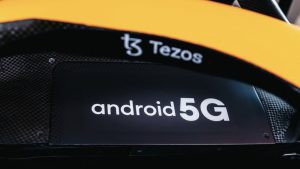Juliya_Ka/Shutterstock
Police have used cars for almost as long as there have been cars. Early police cars were nothing more than regular consumer versions with special badging. Police departments later added radios and lights, but changed little more about the cars. The first police packages offered by the manufacturer came about in 1950 from Ford, with the other major Detroit companies following soon after, per Car Buzz. Since then, police cars have become faster and more capable, equipped with a raft of high-tech equipment from computers to surveillance devices.
For most of the last 60 years, police cars in the U.S. have been versions of the most popular large sedans, capable of comfortably carrying a couple of passengers — or perpetrators — and extra equipment in the truck, such as weapons. Sometime in the ’80s, some departments saw a benefit from using sports cars to patrol highways, and manufacturers responded with police versions of their most popular fast cars, offering a few lucky officers the opportunity to cruise in something a bit more fun.
Around the world, a select few really lucky officers get to patrol in cars few of us will ever get to drive, much less ride in. While most departments must adhere to strict budget guidelines, lest they anger the taxpayers for unnecessary opulent spending, high-performance cars are often donated to departments for publicity, while other cars are confiscated from criminals. Scanning the globe for the most interesting choices, we present the 10 most incredible police cars of all time.
Bugatti Veyron
To be fair, the list of incredible cars in the fleet of the Dubai police force could make most billionaires jealous. The inclusion of the Ferraris, Porsche, Mercedes, and McLarens is long enough to be a stand-alone article itself, so we are including the most incredible of the fleet: a Bugatti Veyron. While it has since been surpassed by the Chiron, it was once the most incredible car in the world, boasting a massive W16 engine with four turbos that spit out more than 1,000 horsepower. It is opulent and luxurious to an intense degree.
With a top speed of more than 200 mph, the police Veyron would have no trouble catching up with speeders in the tiny Arab nation, but it is not really used for such tasks. The Dubai police, according to CNN, use their Veyron mostly for tourist duty. And it is not for catching tourists committing crimes, but for publicity of the city itself. Another purpose is to make the police appear more approachable, friendly, and helpful, and officers welcome tourists’ questions and pictures with the car. It raises the reputation of the city and, hopefully, attracts yet more visitors ready to spend the much-needed tourism dollars, or dirhams, the local currency.
Ford Mustang SSP
By 1982, Police had long been known for using cars powered by big V8 engines for chasing baddies. Police packages were commonplace orders for police departments and the “cop car” was a sight familiar to all citizens not living in a hole. However, California Highway Patrol started using a different V8-powered car for issuing citations, the Ford Mustang. Ford offered the Mustang with a Special Service Package, or SSP, starting in 1982, and sold more than 15,000 copies by the end of the program in 1993 (via MotorTrend). Since the CHP mission was primarily to cite drivers for infractions rather than taking criminals into custody, a smaller car with two doors was an acceptable patrol car, especially when it could catch speeders faster.
While these Mustangs spent years controlling highway traffic, a few of them were called up for a most interesting duty. But the appearance of Mustangs in black and white caught the attention of a U.S. Air Force officer who worked with the U-2 spy plane program. Due to the extraordinary dimension of the high-flying aircraft, pilots needed assistance from other eyes on the ground to maneuver the planes properly for safe takeoff and landing. Air Force pilots have long used powerful V8 American cars to do this, but the Mustangs looked perfectly poised for the task. Therefore, the USAF ordered 19 SSP Mustangs between 1986 and 1991 to do spotter duty for the U-2, and a few lucky servicemen got to buy them when the cars were retired.
Chevrolet Camaro B4C
Not to be outdone by rival Ford, Chevrolet upped its police car game with the 1991 Camaro B4C police package. Equipped with the legendary tuned-port injected small block Chevy V8, the B4C provided patrol duty for state troopers until 2002, when the Camaro line was retired altogether … temporarily. The special police Camaros featured many upgrades including sway bars, brakes, a high-output alternator for the additional lights and radios, and separate coolers for the engine, transmission, and power steering, per Zero 260. The final upgrade was a speedometer that topped out at 145 mph.
Hemmings has a rundown of one purchased in Florida in 2021, noting the previously mentioned upgrades. The service package was essentially the same as a Z28, but still badged as the RS. Also mentioned are the additions of non-Z28 upgrades, such as the shotgun rack and remote control for a radar detector. The later model year cars were properly fast and probably not a welcome sight to lead-footed drivers of the ’90s.
Dodge Monaco
Paras Griffin/Getty Images
This is not really a car that ever saw service in police duty, but it is so iconic, it felt right to include. The 1980 classic John Landis film about Jake and Elwood Blues, played by John Belushi and Dan Akroyd, in their quest to race to raise funds to save an orphanage from imminent destruction, features some of the wildest chase scenes and the most cars ever destroyed on film, according to Motor Authority. The Dodge Monaco police car, a.k.a the “Blues Brothers” Bluesmobile, is a ratty old sedan — rigged with a giant loudspeaker on the roof at one point — that is wrecked, beaten, and literally destroyed throughout the film.
The chase scene through Chicago toward the end of the film involves 60 Illinois State Police cars, 17 ambulances, 42 Chicago Police cars, four Sherman tanks, and hundreds of officers. Throughout the film, 13 Monaco police cars were used to stand in for the Bluesmobile and gave way to one of the most memorable lines of the movie. Sitting in the car assessing their readiness to start the journey, Elwood proclaims of the car, “It’s got a cop motor, a 440-cubic-inch plant. It’s got cop tires, cop suspension, cop shocks. It’s a model made before catalytic converters, so it’ll run good on regular gas. What do you say? Is it the new Bluesmobile or what?” It may not have seen official duty, but it is still an incredible police car.
Dodge Challenger Hellcat
Raymond Boyd/Getty Images
They say everything is bigger in Texas. Apparently, that includes the cop’s horsepower ratings. In October 2022, the Texas Highway Patrol acquired a 1,080 horsepower 2020 Dodge Challenger Hellcat to add to its fleet. The acquisition and use of the car is meant to be a warning to street racers, as it will outrun almost all other cars on Texas highways, and it was awarded to the department as a result of a highly dangerous street racer.
According to The Drive, Texas Highway Patrol spotted the Challenger and another car speeding down Interstate 10 West, trying to catch up and pull the vehicles over. When speeds reached 160 mph, officers chose to end their pursuit as the speeds had become perilously dangerous, and instead they tracked the vehicles from the air. The driver was apprehended when the car ran out of gas and he ran on foot. The result of his reckless behavior was having the car awarded to the Texas Department of Public Safety, among other punitive measures. Now the car can serve highway duty while its story shall serve as a cautionary tale. Moral of the story is, don’t mess with Texas.
Lamborghini Huracan
FilippoPH/Shutterstock
Unlike the Autobahn, the Italian counterpart, the Autostrada, does have limited speeds throughout. Although the Italians have a reputation for being wild drivers and ignoring speed limits, they are, in reality, strictly enforced. While most Italian police have to make do with a variety of small Fiats and Alfas, the Italian State Police force has at least one Lamborghini. It started in 2004, according to Car Scoops, when Lamborghini donated a 2004 Gallardo LP560-4 to the state police. This was done so that the Sant’Agata Bolognese company can retain a congenial relationship with law enforcement.
The Gallardo was well-received by the police and the public so much that Lamborghini replaced it with another car in 2009, this time a Huracan. Thirty lucky polizia get to drive the Huracan, and all of them receive special instruction from Lamborghini before being certified to drive the car on patrol. To add to the goodwill and public perception, in 2020, the police liveried Lambo was used to deliver a kidney from Padua to Rome, a 300-mile trip, in just two hours, per Jalopnik. When you build a product enabling citizens to destroy speed limits and every sense of good judgment, it can be helpful to endear yourself to the law from time to time.
Alfa Romeo Giulia QV
Due to an odd quirk in history and law, Italy has two official police forces. One is the state police, or polizia, and the other is a branch of the military, the carabinieri. While they both have duties of law enforcement, their missions differ somewhat, as do their internal structures. The carabinieri, according to the BBC, predates the Republic of Italy with a history spanning two centuries. The primary differences, in a nutshell, are that the polizia act to keep civil order among citizens, while the carabinieri act to protect national security interests. While some interests are overlapping, the polizia may work to detain heads of crime syndicates, while the carabinieri may work to detain terrorist suspects.
Regardless of their duties, it is often helpful to have fast transportation to respond to crimes and emergencies. To facilitate such a response, in 2021, Alfa Romeo worked in partnership with the carabinieri to provide 1,770 units for officers to use in the field, according to al Volante. They are called Radiomobile 2.0 and are fitted with 2.0 turbocharged gas engines with 200 horsepower and eight-speed transmissions. They are also armored with shatterproof windows, a complement of emergency lights, and weapons mounts. While they are not quite as fast as a Huracan, having nearly 2,000 more units at their disposal will make them ultimately more useful.
BAC Mono
John Keeble/Getty Images
While the Isle of Man, a British Crown Dependency in the Irish Sea, covers a mere 227 square miles of land mass and is home to less than 90,000 people, it still needs police. The amount of paved roads is less than 1,000 miles, yet is host to one of the longest-running motorcycle races in the world, the Isle of Man TT. But outside of racing an officially sanctioned event, Manx people need to keep below the speed limit, or they may find themselves pulled over by a BAC Mono in official police livery.
The Mono is a track day car with a look similar to what you might see in F1 racing. According to the company, Briggs Automotive Company is a Liverpool-based manufacturer specializing in small road cars designed for the track. Hand-built and extremely lightweight, the Mono’s 2.5-liter, 4-cylinder engine produces over 300 horsepower and speeds it up to 60 mph in just 2.8 seconds, with a top speed of 170. It is blazingly fast. And Car Throttle tells us that the Isle of Man police had one donated to them. While it is a publicity move for the small company, the car is used for regular patrols and as a promotional tool to encourage safe driving. If you find yourself driving on the island, it would not be wise to try to outrun this car. You will not be successful.
Saleen Mustang
betto rodrigues/Shutterstock
Steve Saleen is a successful race car driver who managed to transform his passion for racing into a lucrative business. Starting in the ’80s, Saleen built a business modifying brand-new Mustangs with performance modifications to the engine and body, marketing them as Saleen Mustangs (via CJ Pony Parts). Saleen Mustangs are popular performance variants similar to the Roush and Shelby cars of the new millennium. More recently, Saleen has been modifying cars from other makes and introduced a boutique supercar called the S1. Saleen means performance for those in the know.
Steve grew up in southern California, which is also the home to his business enterprises. Like other manufacturers before him, he donated one of his highly modified Mustangs to the Riverside, CA police department in 2017, according to the company’s official website. This car is modified with a twin-screw supercharger and tuned by Saleen to produce a hefty 730 horsepower. It is also equipped with all the standard police equipment, such as a full regiment of emergency lighting. While the car is fully equipped for crime-fighting duty, its main purpose is to support and raise awareness and funding for the Police Officers’ Assistance Fund, which helps families of officers who are killed in the line of duty. Regardless of how it will be used, only officers trained on using the car will be able to drive it, and Saleen is offering specialized driving instruction at their headquarters.
Chevrolet Biscayne
Gestalt Imagery/Shutterstock
Chevrolet introduced the Biscayne model in 1958, and it was discontinued in 1972 (per Conceptcarz.com). It was sold as a full-size car that was meant to be more affordable than the Bel Air, and most Biscaynes were stripped-down cars with few, if any, options added. It was also the first car Chevrolet offered as a fleet police car. It was a good choice for being the more affordable model, and came with a hefty 348-cubic-inch V8 with plenty of power, capable of punching the car to an impressive 135 mph (via Jalopnik). Affordable cars with lots of room and good performance made the right mix for police of the era.
While no officers on the force today will be doing any patrols in it, the Santa Cruz Police Department has one perfectly restored 1961 Biscayne in period-correct blue paint, complete with lights, radio, and department badges displayed on the doors. According to the Santa Cruz Police Department’s official blog, the old Biscayne is used at public events to connect with the community and, in 2015, it won first place in an Emergency Vehicle Display show, for which the department appeared to be very proud. Another post in 2013 shows the department visiting residents of a senior center who were blessed with a ride in the cruiser, most likely bringing back memories of their own — although it is not guaranteed that all of them were necessarily good ones.

